How can home improvement products enhance aesthetic appeal?
Home improvement products can significantly enhance the aesthetic appeal of a space by introducing new colors, materials, and designs that transform the overall look and feel. By carefully selecting these products, homeowners can create a cohesive and inviting atmosphere that reflects their personal style.
Color schemes and palettes
Choosing the right color schemes and palettes is essential for creating a visually appealing environment. Consider using complementary colors to create harmony or contrasting shades to add vibrancy. For example, a neutral base with bold accent colors can make a room feel both sophisticated and lively.
When selecting colors, think about the mood you want to evoke. Soft pastels can create a calming atmosphere, while bright hues can energize a space. Use color swatches to visualize how different shades work together before making a final decision.
Material choices and textures
The choice of materials and textures plays a crucial role in enhancing aesthetic appeal. Incorporating a variety of textures, such as smooth wood, soft fabrics, and sleek metals, can add depth and interest to a room. For instance, pairing a plush sofa with a glass coffee table creates a striking contrast.
Consider the durability and maintenance of materials as well. Natural materials like stone and wood can provide timeless beauty but may require more upkeep. Synthetic options can offer similar aesthetics with less maintenance, making them a practical choice for busy households.
Lighting solutions
Effective lighting solutions can dramatically alter the aesthetic of a space. Layering different types of lighting, such as ambient, task, and accent lighting, creates a balanced and inviting atmosphere. For example, using pendant lights over a dining table can highlight the area while providing functional illumination.
When choosing lighting fixtures, consider their style and how they complement other design elements. Warm-toned bulbs can create a cozy ambiance, while cooler tones can make a space feel more modern. Dimmers are also a great addition, allowing you to adjust the brightness according to the occasion.
Furniture and decor integration
Integrating furniture and decor effectively enhances the overall aesthetic appeal of a room. Select pieces that not only fit the space but also reflect your personal style. For example, a vintage armchair can add character to a contemporary living room.
Be mindful of scale and proportion when arranging furniture. Ensure that larger pieces do not overwhelm the space and that smaller items are not lost. Accessories like artwork, rugs, and plants can further enhance the decor, tying the room together and adding visual interest.
What are the top home improvement products for aesthetics?
The top home improvement products for aesthetics enhance the visual appeal of living spaces. Key categories include paints and finishes, flooring options, wall art and decor, and window treatments, each contributing uniquely to the overall design.
Paints and finishes
Paints and finishes are fundamental in transforming the look of any room. Selecting the right color palette can create a mood, while finishes like matte, satin, or gloss can affect light reflection and texture. Consider using low-VOC paints for a healthier indoor environment.
When choosing paint, test samples on your walls to see how they look in different lighting throughout the day. For finishes, remember that glossier options are easier to clean but may highlight imperfections more than matte finishes.
Flooring options
Flooring significantly impacts a room’s aesthetic, with options ranging from hardwood and laminate to tile and carpet. Each type offers distinct advantages; for example, hardwood provides warmth and elegance, while tiles are durable and easy to maintain.
When selecting flooring, consider the room’s function and traffic levels. For high-traffic areas, durable materials like vinyl or tile may be preferable, while softer options like carpet can enhance comfort in bedrooms or living rooms.
Wall art and decor
Wall art and decor personalize a space and can serve as focal points. Options include paintings, photographs, mirrors, and decorative shelves. Choose pieces that reflect your style and complement the room’s color scheme.
Mixing different types of art can create visual interest. For example, combining framed art with three-dimensional pieces or wall-mounted plants can add depth and character to your walls.
Window treatments
Window treatments not only enhance privacy but also contribute to a room’s overall aesthetic. Options include curtains, blinds, and shades, each offering varying levels of light control and style. Consider fabric types and colors that harmonize with your decor.
When selecting window treatments, think about the room’s lighting needs and the desired ambiance. Light, airy fabrics can brighten a space, while heavier materials can add warmth and coziness.
How do I choose the right home improvement products?
Choosing the right home improvement products involves assessing your personal style, understanding the dimensions of your space, and evaluating the durability of the products. These factors will help ensure that your selections not only enhance the aesthetic appeal of your home but also meet practical needs.
Assessing personal style
Your personal style is crucial in selecting home improvement products that resonate with your taste. Consider whether you prefer modern, traditional, or eclectic designs, as this will guide your choices in colors, materials, and finishes.
To refine your style, browse through design magazines or online platforms like Pinterest for inspiration. Create a mood board to visualize how different elements can come together in your space.
Understanding space dimensions
Knowing the dimensions of your space is essential when choosing home improvement products. Measure the area where you plan to install or place items to ensure they fit well and do not overwhelm the room.
For example, when selecting furniture or fixtures, consider not only their size but also how they will interact with existing elements like doors and windows. A common rule is to leave at least 24 inches of walking space around furniture to maintain a comfortable flow.
Evaluating product durability
Durability is a key factor in choosing home improvement products, as it affects both longevity and maintenance. Look for materials that are known for their resilience, such as hardwood for flooring or stainless steel for fixtures.
Research product reviews and manufacturer warranties to gauge the expected lifespan and performance of items. Avoid products with limited warranties or those made from lower-quality materials, as they may require frequent replacements, leading to higher long-term costs.
What are the latest trends in home improvement aesthetics?
The latest trends in home improvement aesthetics focus on creating spaces that are not only visually appealing but also functional and sustainable. Key trends include biophilic design, smart home integration, and minimalist approaches that prioritize simplicity and efficiency.
Biophilic design elements
Biophilic design incorporates natural elements into home improvement projects to enhance well-being and connection to nature. This can include features like living walls, large windows that invite natural light, and the use of natural materials such as wood and stone.
When considering biophilic elements, think about adding indoor plants or water features that promote tranquility. Research suggests that these features can improve air quality and reduce stress, making them a worthwhile investment for homeowners.
Smart home integration
Smart home integration involves incorporating technology to enhance the functionality and convenience of living spaces. This includes smart lighting, thermostats, and security systems that can be controlled remotely, offering both comfort and energy efficiency.
To effectively integrate smart technology, assess your needs and choose devices that work well together. Look for systems that are compatible with existing home networks and consider energy-efficient options that can lower utility bills over time.
Minimalist approaches
Minimalist approaches in home improvement emphasize simplicity and decluttering, focusing on essential elements that serve a purpose. This trend often features neutral color palettes, clean lines, and multifunctional furniture that maximizes space.
To adopt a minimalist aesthetic, start by evaluating your current decor and removing items that do not contribute to your lifestyle. Invest in quality over quantity, selecting pieces that are both functional and visually appealing, which can create a serene and organized environment.
How do home improvement products impact property value?
Home improvement products can significantly enhance property value by improving aesthetics and functionality. Upgrades that appeal to potential buyers often lead to higher selling prices and quicker sales.
ROI on aesthetic upgrades
The return on investment (ROI) for aesthetic upgrades varies based on the type of improvement and the local market. Generally, cosmetic enhancements like fresh paint, landscaping, and updated fixtures can yield returns between 60% to 90% when selling a home.
Consider focusing on upgrades that have broad appeal, such as neutral paint colors or modern lighting fixtures. These changes can attract more buyers and potentially increase offers.
Be cautious with highly personalized renovations, as they may not resonate with all buyers. Stick to improvements that enhance the overall look and feel of the property without straying too far from common trends in your area.





